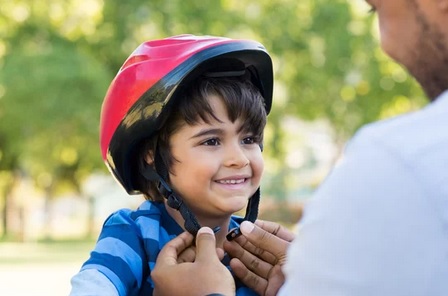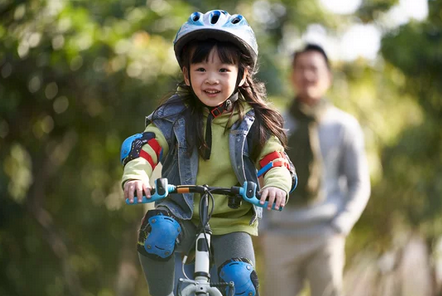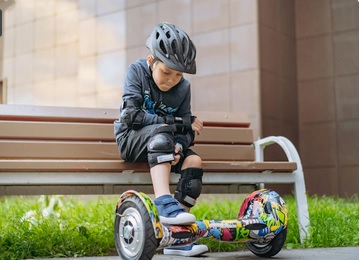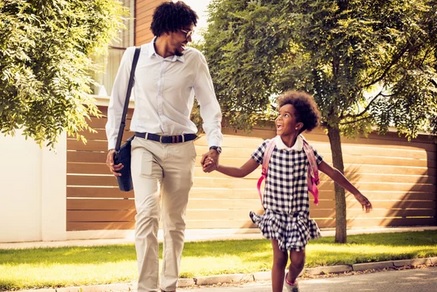 BICYCLE SAFETY
BICYCLE SAFETY
Kids and bikes go together like peanut butter and jelly! Bikes offer children fun, freedom and great exercise!
We obviously want kids and families to enjoy riding their bikes, but we also want everyone to stay safe. That’s why bicycle helmets are so important. Studies show that properly-fitted helmets can drastically reduce the risk of head injuries.
The American Academy of Pediatrics (AAP) recommends that children, teens and their adult caregivers should always wear a properly-fitted bicycle helmet while biking.
The risks of physical injuries, including traumatic brain injuries are highest for children 5-14 years of age (76.6/1000 persons) and youth 15-24 years of age (55.6/1000 persons). The risk of head, brain and severe brain injury has been shown to decrease by 63-88% for bicyclists of all ages when using helmets. Moreover, helmet use is cost-effective in preventing head injuries.
 It’s not only the right thing to do, it’s the law! California Law requires that everyone under 18 years of age must wear a helmet while biking. Children 5 years of age and younger who ride as bike passengers (in a bike trailer or stroller) are required by law to wear a helmet.
It’s not only the right thing to do, it’s the law! California Law requires that everyone under 18 years of age must wear a helmet while biking. Children 5 years of age and younger who ride as bike passengers (in a bike trailer or stroller) are required by law to wear a helmet.
AAP has released a policy statement (click here to read it) as well as a technical report (click here) outlining Helmet Use in Preventing Head Injuries in Bicycling, Snow Sports, and Other Recreational Activities and Sports from the AAP Council on Injury, Violence and Poison Prevention.
The National Highway Traffic Safety Administration (NHTSA) has created a terrific flyer to help instruct parents on how to properly fit a bicycle helmet (for a child or an adult). Click here to download the flyer. The federal agency has also released a video on bike riding safety. Click here to watch the video.
The AAP HealthyChildren.org website has written an article to help parents keep their kids safe while on bikes. To read the article, click here.
To help do our part, Clinic in the Park has partnered with the Newport Sunrise Rotary Club to educate, fit and distribute hundreds of bicycle helmets at Family Health Day events in Orange County.
 MICROMOBILITY PRODUCTS
MICROMOBILITY PRODUCTS
Micromobility products include E-bikes, E-Scooters and Hoverboards. The use of these products has increased in recent years. Unfortunately, so has the number of injuries associated with these products. In fact, the number of emergency department visits associated with micromobility products more than doubled between 2017 (34,000 visits) and 2021 (77,200 emergency room visits).
Click here to read an article on electric bike (e-bike) safety concerns by Phyllis Agran, MD, FAAP. The article has been published on the AAP’s parent resources website, HealthyChildren.org.
Click here to review safety tips for micromobility products from the U.S. Consumer Product Safety Commission (CPSC). The CPSC has also released a short video (click here to watch it) to help parents keep their kids safe when operating micromobility products.
PEDESTRIAN SAFETY
 Walking and bike riding are healthy ways to get to and from school. Skipping the school drop-off traffic for more active commutes can contribute to the recommended 60 minutes of physical activity kids need each day. Trips powered by feet, rather than vehicles, also can help reduce pollution, which can trigger breathing problems in children. Walking can also help make neighborhoods friendlier places.
Walking and bike riding are healthy ways to get to and from school. Skipping the school drop-off traffic for more active commutes can contribute to the recommended 60 minutes of physical activity kids need each day. Trips powered by feet, rather than vehicles, also can help reduce pollution, which can trigger breathing problems in children. Walking can also help make neighborhoods friendlier places.
Children usually aren’t ready to start walking to school without an adult until about fifth grade, or around age 10. Younger children are more impulsive and less cautious around traffic, and they often don’t fully understand other potential dangers they could come across.
Click here for a detailed article regarding walking your child to school from HealthyChildren.org, the parent page of the American Academy of Pediatrics (AAP).
We also encourage you to visit Stop4Aidan, which is a website that was established by parents of a young child (Aidan) who tragically was killed while walking in a crosswalk. The website is intended to inform, educate, and advocate for better laws to protect pedestrians and cyclists.
